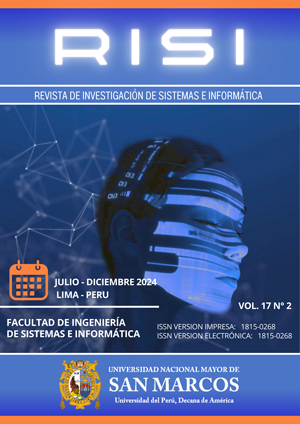Use of class balancing tools to improve the performance of classification models in estimating the time of the maximum electrical demand
DOI:
https://doi.org/10.15381/risi.v17i2.29154Keywords:
Unbalanced classes, support vector machine, logistic regression, oversampling, undersamplingAbstract
Estimating the time of occurrence of the maximum electrical demand is useful to establish the magnitude of the electrical generation required to satisfy it, to establish differentiated rates to “flatten” the load curve, among other reasons. This time of demand occurrence could belong to daytime or nighttime, with a clear imbalance towards the latter. The objective of this research is to improve the performance of forecast models for the time of occurrence of maximum electrical demand by applying tools for class balance. We worked with historical data from a South American country from the period 2021-2024, and support vector machine and logistic regression algorithms are used to generate the classification models. The class balancing methods considered were SMOTE, SMOTE-NC, as well as the class weight adjustment argument of the machine learning algorithms themselves. For each algorithm, four models were generated: one with unbalanced classes, others with balanced classes with the weight adjustment argument, another using the SMOTE-NC method, and the fourth using the SMOTE method. As a result, it was obtained that the models in which the SMOTE-NC method was present had the greatest improvements in their performance metrics, which were: Accuracy, Precision, F1, and Recall.
Downloads
Downloads
Published
Issue
Section
License
Copyright (c) 2024 César Aristóteles Yajure Ramírez

This work is licensed under a Creative Commons Attribution 4.0 International License.
AUTHORS RETAIN THEIR RIGHTS:
a. Authors retain their trade mark rights and patent, and also on any process or procedure described in the article.
b. Authors retain their right to share, copy, distribute, perform and publicly communicate their article (eg, to place their article in an institutional repository or publish it in a book), with an acknowledgment of its initial publication in the Revista de investigación de Sistemas e Informática.
c. Authors retain theirs right to make a subsequent publication of their work, to use the article or any part thereof (eg a compilation of his papers, lecture notes, thesis, or a book), always indicating its initial publication in the Revista de investigación de Sistemas e Informática (the originator of the work, journal, volume, number and date).


